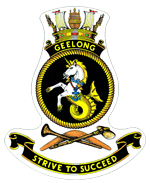HMAS Geelong (J201)
 HMAS Geelong traveling at full speed while escorting a convoy off New Guinea in September 1944 | |
| Career (Australia) | |
|---|---|
| Namesake: | City of Geelong, Victoria |
| Builder: | HMA Naval Dockyard |
| Laid down: | 16 October 1940 |
| Launched: | 22 April 1941 |
| Commissioned: | 16 January 1942 |
| Motto: | "Strive To Succeed" |
| Honours and awards: |
Battle honours Pacific 1942–44 New Guinea 1944 |
| Fate: | Lost following a collision, 18 October 1944 |
| Badge: |
 |
| General characteristics | |
| Class & type: | Bathurst class corvette |
| Displacement: | 650 tons (standard), 1,025 tons (full war load) |
| Length: | 186 ft (57 m) |
| Beam: | 31 ft (9.4 m) |
| Draught: | 8.5 ft (2.6 m) |
| Propulsion: | triple expansion engine, 2 shafts, 1,750 hp |
| Speed: | 15 knots (28 km/h; 17 mph) at 1,750 hp |
| Complement: | 85 |
| Armament: |
1 x 4-inch gun 3 x 20 mm Oerlikons Machine guns Depth charges chutes and throwers |
HMAS Geelong (J201), named for the city of Geelong, Victoria, was one of 60 Bathurst class corvettes constructed during World War II, and one of 36 initially manned and commissioned solely by the Royal Australian Navy (RAN).[1]
Geelong was lost after a collision on 18 April 1944.[1] She was one of only three Bathurst class corvettes lost during World War II.
Construction
Geelong was laid down by HMA Naval Dockyard at Williamstown, Victoria on 16 October 1940.[1] She was launched on 22 April 1941 by the wife of Lord Winston Dugan, then Governor of Victoria, and was commissioned into the RAN on 16 January 1942.[1]
Operational history
After commissioning, Geelong visited her namesake city before undergoing working up trials.[1] On completion, the corvette was assigned as a minesweeper and anti-submarine patrol ship along the east coast of Australia, before being redeployed to New Caledonia on 8 March 1942 to perform similar duties.[1] In May 1942, Geelong returned Sydney, and was one of several Allied vessels located in Sydney Harbour during the Japanese midget submarine attack of 31 May 1942.[1][2] In June, the ship began convoy escort runs between Sydney and Brisbane, which continued until January 1944, when she sailed to Adelaide for a two-month refit.[1]
After the refit, Geelong briefly operated in Australian waters before being assigned to New Guinea.[1] Using Milne Bay as a base of operations, the corvette served as a convoy escort and anti-submarine patrol ship throughout the South West Pacific Area.[1]
Fate
On 18 October 1944, Geelong collided with the American tanker York and sank north of Langemak, New Guinea, at 6°4′S 147°45′E / 6.067°S 147.750°E.[1] No lives were lost, with the survivors picked up by York and transported to Langemak.[1]
Geelong was one of only three Bathurst class ships to be lost during World War II, and one of two lost to collision.
The ship received two battle honours for her wartime service: "Pacific 1942–44" and "New Guinea 1944".[3][4]
References
- ↑ 1.0 1.1 1.2 1.3 1.4 1.5 1.6 1.7 1.8 1.9 1.10 1.11 "HMAS Geelong (I)". HMA Ship Histories. Sea Power Centre – Royal Australian Navy. Retrieved 24 December 2008.
- ↑ Jenkins, David (1992). Battle Surface! Japan's Submarine War Against Australia 1942–44. Milsons Point: Random House Australia. pp. 193–4. ISBN 0-09-182638-1.
- ↑ "Navy Marks 109th Birthday With Historic Changes To Battle Honours". Royal Australian Navy. 1 March 2010. Archived from the original on 13 June 2011. Retrieved 23 December 2012.
- ↑ "Royal Australian Navy Ship/Unit Battle Honours". Royal Australian Navy. 1 March 2010. Archived from the original on 14 June 2011. Retrieved 23 December 2012.
| ||||||||||||||||||||||||